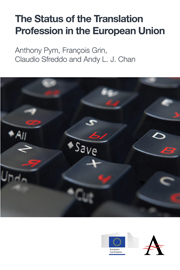Book contents
- Frontmatter
- Contents
- GENERAL INTRODUCTION
- 1 METHODOLOGICAL ISSUES
- 2 RESULTS
- 3 CASE STUDIES
- 4 SOCIOLOGICAL MODELLING
- 5 ECONOMIC MODELLING
- 6 POLICY OPTIONS FOR ENHANCED SIGNALLING
- 7 RECOMMENDATIONS
- APPENDIX A Translator Associations: Years of Foundation and Numbers of Members
- APPENDIX B Why There Are About 333,000 Professional Translators and Interpreters in the World
- APPENDIX C Online Translator—Client Contact Services: New Modes of Signalling Status
- APPENDIX D Types and Use of Economic Perspectives on Translation
- APPENDIX E Equilibrium on the Translation Market
- NOTES
- REFERENCES
- ACKNOWLEDGEMENTS
- NOTES ON THE RESEARCH TEAM
GENERAL INTRODUCTION
Published online by Cambridge University Press: 05 April 2014
- Frontmatter
- Contents
- GENERAL INTRODUCTION
- 1 METHODOLOGICAL ISSUES
- 2 RESULTS
- 3 CASE STUDIES
- 4 SOCIOLOGICAL MODELLING
- 5 ECONOMIC MODELLING
- 6 POLICY OPTIONS FOR ENHANCED SIGNALLING
- 7 RECOMMENDATIONS
- APPENDIX A Translator Associations: Years of Foundation and Numbers of Members
- APPENDIX B Why There Are About 333,000 Professional Translators and Interpreters in the World
- APPENDIX C Online Translator—Client Contact Services: New Modes of Signalling Status
- APPENDIX D Types and Use of Economic Perspectives on Translation
- APPENDIX E Equilibrium on the Translation Market
- NOTES
- REFERENCES
- ACKNOWLEDGEMENTS
- NOTES ON THE RESEARCH TEAM
Summary
The status of translators is not to be confused with how well anyone translates. It concerns the perception of a translator's value — what people think a particular translator can do, and how well or badly the translator is assumed to do it.
Seen as such, the question of status is extremely important because, almost by definition, someone who needs a translator cannot judge objectively how well that translator performs. Translations are among the products and services, perhaps along with used cars and legal services, where the buyer does not have direct knowledge of what they are buying — they have to rely on what people say, or on what the translator looks like, or on the translator's academic qualifications, or their membership of professional associations, or their official certification. That is, status is created by a set of social signals, which come in many shapes and sizes. Without those signals, the users of translations would be involved in an endless process of trial-and-error, as can indeed happen when buying a used car or trusting a lawyer.
These days the question of status is of particular importance because, with a website and business model, virtually anyone can start certifying translators. It is not excessively hard to supply novice translators with the external trappings of a profession: an official stamp, a place in an official-looking list, perhaps letterhead paper or a corporate email address.
- Type
- Chapter
- Information
- The Status of the Translation Profession in the European Union , pp. vii - viiiPublisher: Anthem PressPrint publication year: 2013

